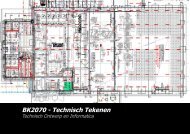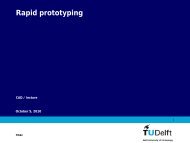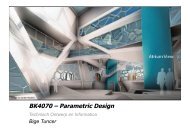esearch variablesprocedure variables•=•=•=dependent variables(behaviour variables)<strong>in</strong>dependent variables (spatialcharacteristics)<strong>in</strong>terven<strong>in</strong>g variables(<strong>in</strong>dividual characteristics)• presentation methods•= response methodsFigure 1: The variables for an assessment of spatial perceptionIn the Sections 3.2.1. 3.2.2 and 3.2.3. research variables will be dealt with, and <strong>in</strong> Section 3.3. theprocedure variables will be expla<strong>in</strong>ed.3.2.1. Dependent variables: determ<strong>in</strong>ants of comfort and public safetyBehavior variables also are referred to as the dependent variables. They are called dependents<strong>in</strong>ce they highly depend on the changes of the <strong>in</strong>dependent variables. Independent variables arespatial characteristics and context, which will be expla<strong>in</strong>ed <strong>in</strong> Section 3.2.2. In this thesis, aspectsof public safety and comfort will have a central place. This means, that first, the determ<strong>in</strong>ants ofcomfort and perception of public safety need to de def<strong>in</strong>ed, so that later their correlation with<strong>in</strong>dependent variables could be established 2 .Public SafetySeveral authors have studied public safety aspects of both underground and abovegroundsett<strong>in</strong>gs. Accord<strong>in</strong>g to Fisher and Nasar (1992), the prospect, refuge and escape have a significant<strong>in</strong>fluence on a person’s perception of public safety. Korz (1998) showed that light, presence ofpeople, overview (prospect) and escape had a significant <strong>in</strong>fluence on public safety perception.De Boer (1997) named four aspects; these be<strong>in</strong>g presence of people, escape, prospect andsurveillance. Van Wegen en Van der Voordt (1991) named presence of people, <strong>in</strong>volvement,visibility, attractiveness of the surround<strong>in</strong>g, accessibility and escape possibilities as importantdeterm<strong>in</strong>ants of public safety.Nasar and Jones (1997) found social and physical elements that were associated with fear andpublic safety. Among physical elements, they named concealment and entrapment as two ma<strong>in</strong>aspects associated with fear. With concealment, they refer to aspects such as hid<strong>in</strong>g places, whichreduce the overview, and dark areas, which reduce visibility and <strong>in</strong>crease uncerta<strong>in</strong>ty. Amongsocial elements, they named absence of others, as eventual surveillance and expectance of help <strong>in</strong>2 S<strong>in</strong>ce the literature on these aspects related to underground stations was not sufficient due to small amount ofconducted research, the literature was consulted that dealt with these aspects, but <strong>in</strong> sett<strong>in</strong>gs other than undergroundspaces.- 26 -
case of emergency. Interest<strong>in</strong>gly, they found fear be<strong>in</strong>g associated with the presence of strangers,which was seen as a possible entrapment. About 96% of the respondents experienced thepresence of groups of people as be<strong>in</strong>g safe. This is important to mention, s<strong>in</strong>ce <strong>in</strong> other research,only “presence of people” has been mentioned, but no specification was made regard<strong>in</strong>g anumber. In this case, presence of one person or very small group can be negatively experienced.On the contrary, presence of more people, but not necessarily <strong>in</strong> large groups, creates the bestcondition for a generally shared feel<strong>in</strong>g of public safety. This aspect was also addressed <strong>in</strong>research of Opperwal and Timmermans (1999), where they conducted a study on aspects that hadan <strong>in</strong>fluence on the pleasantness rat<strong>in</strong>g of shopp<strong>in</strong>g centers. Accord<strong>in</strong>g to the authors, peopletended to dislike crowded and very un-crowded areas (deserted areas with few people).Moderately un-crowded shopp<strong>in</strong>g centers were perceived as most pleasant, while very crowdedcenters were disliked and negatively experienced. Van der Voordt and Van Wegen (1990) statethat the presence of people is important, but that excessively crowded places may have a negativeimpact.Hav<strong>in</strong>g public safety as a basic assumption for perception of underground station, Laarhoven(1997) considers follow<strong>in</strong>g aspects:•= a public control of the route to the station•= a degree and a nature of activities <strong>in</strong> the station’s surround<strong>in</strong>g•= spatial organization/ layout of the station•= light<strong>in</strong>g•= presence of people and•= a degree of surveyabilityThe author stresses out the importance of consider<strong>in</strong>g the surround<strong>in</strong>g and its quality as well.This is a natural choice s<strong>in</strong>ce the station is a part of larger area and any problems that are evident<strong>in</strong> the surround<strong>in</strong>g may as well be reflected <strong>in</strong> the build<strong>in</strong>g as well.The aspect of daylight was found to have an <strong>in</strong>fluence on perception of public safety. Naser andJones (1997) found that the routes respondents needed to take dur<strong>in</strong>g their research wereexperienced as more safe, dur<strong>in</strong>g the daytime than dur<strong>in</strong>g the nighttime. Korz (1998) showed that<strong>in</strong> the late hours, an <strong>in</strong>dividual expects a smaller number of people be<strong>in</strong>g present at the stations(both above and underground) and therefore they expect more crime to happen <strong>in</strong> these hours.The aspects that were considered until now were primarily related to public safety, together withthe way <strong>in</strong> which they can <strong>in</strong>fluence perception of comfort. Later <strong>in</strong> the text, the determ<strong>in</strong>ants ofcomfort will be expla<strong>in</strong>ed.Comfort – PleasantnessAn aspect that is often dealt with <strong>in</strong> the literature and related to comfort is the orientation or thewayf<strong>in</strong>d<strong>in</strong>g aspect (Pass<strong>in</strong>i 1984, 1992; Arthur 1992; Galen 1999). Pass<strong>in</strong>i (1992) def<strong>in</strong>es spatialorientation” as the ability of a person to determ<strong>in</strong>e where he is with<strong>in</strong> a physical sett<strong>in</strong>g”.Thereafter he adds that this def<strong>in</strong>ition needs “to be extended to <strong>in</strong>clude an alternative ability thatconsists <strong>in</strong> determ<strong>in</strong><strong>in</strong>g what to do <strong>in</strong> order to reach a place” (p. 43). He goes further expla<strong>in</strong><strong>in</strong>gthat a person may rely on spatial representation of the physical environment as well as on a planof action or a strategy to go somewhere. Accord<strong>in</strong>g to Pass<strong>in</strong>i, the sensation of be<strong>in</strong>g disorientedwould arise only if a person is deprived of both. In such case the feel<strong>in</strong>g of discomfort and- 27 -
- Page 5: ContentsChapter 1 Introduction 11.1
- Page 9 and 10: CHAPTER 1Introduction1.1. Backgroun
- Page 11 and 12: In the Netherlands, most publicly u
- Page 13 and 14: spaces. There are also other aspect
- Page 15 and 16: The information to be processed is
- Page 17 and 18: CHAPTER 2From spatial planing to pe
- Page 19 and 20: In short, utilizing underground spa
- Page 21 and 22: Up until now it has been shown that
- Page 23 and 24: the information but also the desire
- Page 25 and 26: Another important conclusion is rel
- Page 27 and 28: develop a generic method to model t
- Page 29 and 30: In order to define the working area
- Page 31 and 32: spatialenvironmenthuman beingmental
- Page 33: CHAPTER 3Identification of the mode
- Page 37 and 38: judgement and experience of space.
- Page 39 and 40: Figure 4: View over the platform. U
- Page 41 and 42: •= Layout including both spatial
- Page 43 and 44: comfort seems to fulfill a biologic
- Page 45 and 46: Spatial CharacteristicsSpatial char
- Page 47 and 48: material/coloroverviewconstructione
- Page 49 and 50: Another aspect is the transparency
- Page 51 and 52: there are three key issues that are
- Page 53 and 54: •= the questions were closed, whi
- Page 55 and 56: CHAPTER 4Theoretical background on
- Page 57 and 58: some way or other has "memory". Add
- Page 59 and 60: XoWEIGHTSArtificial NeuronX1X2 Wj2.
- Page 61 and 62: Xthe inputspace(domain)inputsoutput
- Page 63 and 64: the text. This implies that general
- Page 65 and 66: numerical values. A variable is cal
- Page 67 and 68: artificial neural networks versus f
- Page 69 and 70: Figure 11: The inverse quadratic fu
- Page 71 and 72: part of the data as receptive field
- Page 73 and 74: The main feature of expert systems
- Page 75 and 76: • Use logical (deductive) reasoni
- Page 77 and 78: CHAPTER 5Experimental research: Cas
- Page 79 and 80: Figure 2: The old and new situation
- Page 81 and 82: Figure 8, 9: Entrance to platform (
- Page 83 and 84: Beurs/Churchillplein station is sit
- Page 85 and 86:
Figure 22, 23: The main entrance to
- Page 87 and 88:
Table 2: Aspects related to comfort
- Page 89 and 90:
5.3.3. ResponseFrom 27 May until 30
- Page 91 and 92:
7060605050404030302020Percentage100
- Page 93 and 94:
5.4.5. Way of orientingIn Figures 4
- Page 95 and 96:
Table 7: Perception of comfort in t
- Page 97 and 98:
CHAPTER 6Experimental research by k
- Page 99 and 100:
of input information i.e., the case
- Page 101 and 102:
Figure 3: Training results for rang
- Page 103 and 104:
Experiment 2aThe first 28 parameter
- Page 105 and 106:
formed by this knowledge model. In
- Page 107 and 108:
Table 4: Hierarchical order of sens
- Page 109 and 110:
Table 8: Hierarchical order of sens
- Page 111 and 112:
information structured as a knowled
- Page 113 and 114:
elationship it is understood to be
- Page 115 and 116:
10.80.60.40.201 4 7 10 13 16 19 22
- Page 117 and 118:
wilhelmina11.624.164.3wilhelmina36.
- Page 119 and 120:
wilhelmina6.720.373rijswijkblaak22.
- Page 121 and 122:
This study considered both metro an
- Page 123 and 124:
Some specific conclusions can be ma
- Page 125 and 126:
wilhelminarijswijkblaakbeurs9.62.59
- Page 127 and 128:
CHAPTER 7Conclusions and recommenda
- Page 129 and 130:
Furthermore, this research is also
- Page 131 and 132:
Additional efforts to improve knowl
- Page 133 and 134:
integrated computational intelligen
- Page 135 and 136:
Appendix A: Questionnaire for Blaak
- Page 137 and 138:
DEEL 3:HET VINDEN VAN DE WEGVraag 1
- Page 139 and 140:
DEEL 8:VERLICHTINGVraag 26: In hoev
- Page 141 and 142:
Appendix B : Learning based data an
- Page 143 and 144:
For further explanation regarding s
- Page 145 and 146:
ReferencesAlsop Architects (2001).
- Page 147 and 148:
COB (2000). Jaarverslag 1999. Centr
- Page 149 and 150:
Leonard J.A., Kramer M.A., and Unga
- Page 151 and 152:
Van Wegen, H. B. R. and Van der Voo
- Page 153 and 154:
SummaryThe intensification, combina
- Page 155 and 156:
aspects, which is derivation of dep
- Page 157 and 158:
SamenvattingBelevingsaspecten van O
- Page 159 and 160:
krachtige combinatie te zijn voor h
- Page 161 and 162:
AcknowledgmentsAfter formal discuss
- Page 163 and 164:
About the authorSanja Durmisevic wa
- Page 165 and 166:
BibliographyJournal publicationsDur
- Page 167:
Ciftcioglu Ö., Durmisevic S. and S





